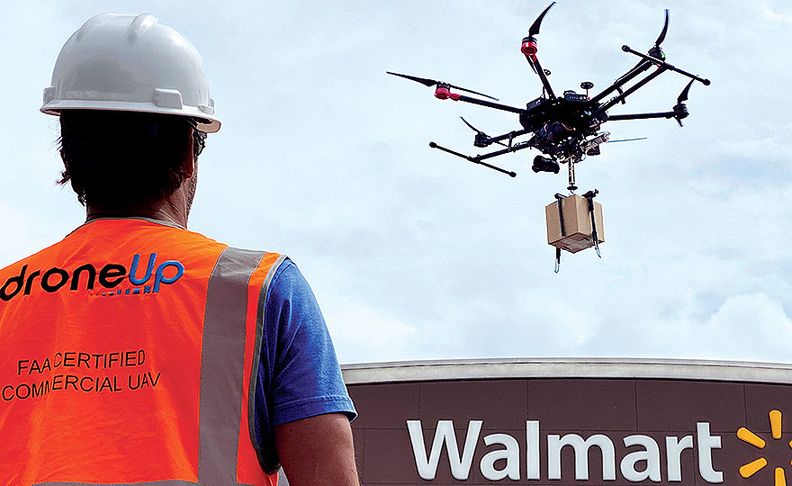Walmart already revolutionized retail logistics once, beginning a half-century ago, with the industry’s first centralized distribution centers and its launch of “continuous replenishment” of goods in stores.
Now, the iconic chain of 4,700 U.S. stores based in Bentonville, Arkansas, is striving for a pole position in the race to utilize autonomous delivery, trying to keep its fabled supply chain a few steps ahead of all other bricks-and-mortar players and to maintain pace in the derby with Amazon and other e-commerce-first platforms.

“We’re solving the right problems for our customers already, and we’re excited about the problems we’re about to solve as we scale up” usage of drones, driverless delivery trucks and other applications of autonomous supply-chain operations, Tom Ward, Senior Vice President of Last-Mile Delivery for Walmart, told StrategicCIO360.com.
“The fact that we have a tremendous asset base that goes from a store to a pick-up center to delivery [node] and now a launch facility for autonomous vehicles means that we’re connecting assets in a way that is hard for any [competitor] to get close to and will make sense for both our company and our customer,” Ward said.
Much as automotive and digital-tech giants keep deploying new experiments in driverless transportation of human beings, Walmart has been leading in testing many types of autonomous delivery of goods. The $560-billion behemoth has unleashed a fleet of experiments, applying lessons learned during the curbside-pickup craze of Covid while leveraging its legendary ability to use technology to optimize supply chains continuously.
“We’re basically focused on what technologies are emerging, what things are happening in the space that allow you fundamentally to better serve the customer,” Ward said. “To think about what busy families need and connect it to our overall mission. It’s about speed, about convenience and obviously about great prices.”
Thus Walmart recently invested in DroneUp, a nationwide drone-services provider that has a federal waiver to allow for delivery flights over people and moving vehicles. That followed its investment in Cruise, the AV outfit started by General Motors, after Walmart launched a delivery pilot with Cruise in Scottsdale, Arizona, last year.
The company also has been piloting deliveries in Arkansas by autonomous box trucks in a partnership with startup Gatik, and this year they’re removing the safety driver. And since 2019, Walmart has been piloting driverless grocery deliveries with Nuro, a robotics startup that also is partnering with other major companies including Domino’s.
“We want to make sure we have a wide net cast when it comes to testing and learning,” Ward said. “With drones, for instance, there is a huge diversity in approach, so we have three partnerships that represent a huge cross-section of technologies.”
Walmart partnered with DroneUp, for instance, last year to launch trial deliveries of at-home Covid self-testing kits. It teamed with Flytrex to deliver groceries and household essentials in Fayetteville, North Carolina. And Walmart is building a partnership with Zipline, best known for deliveries of medical supplies in Africa, for on-demand deliveries of health and wellness products early next year. “Zipline has a fixed-wing approach that launches from a catapult and deploys a package that can land in your backyard with a biodegradable parachute,” Ward explained.
“We want to learn what customers like and what makes sense in different situations. Once we get the formula right, and what works for the customer, we accelerate and move into that space really quickly.”
Walmart also moves out of technologies quickly if they’re not ringing the bell. For example, five years ago the company began introducing 17-foot-tall towers for automated pickup of online orders inside stores. The towers, by Estonia-based Cleveron, could hold up to 300 small to medium-sized packages, accept a code entered by a customer and open a bin allowing them to collect their online purchase and be on their way—all in less than a minute.
But once the pandemic hit last year, customers preferred outside service such as curbside pickup, so by early this year, Walmart discontinued the towers. “As customers evolve, we’ll be bold in disrupting the strategy we have,” Ward said. “The core thing is we can move with speed and also disrupt with speed.”
Fundamentally, he said, “what customers want is choice” in fulfillment of their orders. “People will change based on their situation. They’ll go into our supercenters because there’s really nothing else like them, especially at seasonal times. Our [smaller] Neighborhood Markets are great solutions for people to stock up on things and if they don’t have time for a large store. But these same customers will do scheduled pickups if they’re going to a football practice and they need 20 bottles of Gatorade.”
Amid an unprecedented labor squeeze, of course the labor-saving aspects of automated delivery technologies are more attractive than ever to Walmart. But testing and ultimately deploying these methods won’t simply translate into fewer employees, Ward said. For instance, as Walmart is “building out last-mile delivery and layering on in-home delivery” in a test, “that space actually involves more associates: We’re sending individuals into the home to place the deliveries, and customers can see them live through a body-vest camera.”
For such reasons, Ward said, “Over the last [year or so], we’ve actually doubled the number of personal shoppers that service online pickup and delivery. So the way we think about it is that we’re people-led and technology-empowered. When you approach the problem from that standpoint, most technologies you see and are used are about creating more access and bringing costs down and closing the loop with the customer. A lot of associates are involved in that system.”









